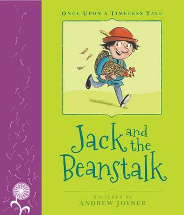Once Upon A Timeless Tale series

Little Hare, 2014.
Jack and the Beanstalk retold by Margrete Lamond with Russell
Thomson. Illustrated by Andrew Joyner. ISBN 9781742975245.
Goldilocks and the Three Bears Retold by Margrete Lamond with
Russell Thomson. Illustrated by Anna Walker. ISBN 9781921894923.
The Princess and the Pea Retold by Margrete Lamond.
Illustrated by Mitch Vane. ISBN 9781921894930.
The Ugly Duckling Retold by Margrete Lamond. Illustrated by
Jonathan Bentley.
(All ages) These are indeed timeless tales, those traditional
stories that are handed down from generation to generation and which
we expect our students come to school already knowing (although that
is often a misconception). These are the original pre-Disney version
of these stories told way back when, retold by Margrete Lamond and
beautifully illustrated by some of the best illustrators for
children, bringing them right into the world of the 21st century
child and a new generation.
While there may be a perception that fairytales such as these are
the domain of the preschooler and very young readers, they actually
have a place on the shelves of every library, primary and secondary.
Firstly, they are a part of our oral culture and there is an
expectation that when you mention a particular story, the students
will know enough of the core story to bring it to mind. So this can
be compared to other cultures whose history has been passed down
orally.
Secondly, the original purpose of such stories was a didactic one -
each had a lesson or a moral to be learned by the younger generation
without putting them physically at risk - so students can not only
examine what that lesson is, but also compare it to the traditional
stories of other cultures to investigate if similar, universal
truths were a common theme.
Thirdly, most of them are now hundreds of years old so what is it
about these stories that mean they have endured over time, place and
space? Even though they have been retold, re-interpreted and
repackaged into a variety of formats, why does the core and essence
remain intact? Why are they told again and again and again and
children's eyes light up when you pick up a familiar one to read to
them? Which of today's stories will survive the test of time? Even
though The Very Hungry Caterpillar is now 45, Corduroy
is now 40, and Hairy Maclary, Hush and Grandma Poss
are all 30-something, do they have whatever it is it takes to notch
up centenaries and bicentenaries?
Finally, for now, these books lend themselves to helping students
understand that critical information literacy skill of
interpretation. Because there are so many versions available it is
easy to collect enough of them to provide the variety required to
examine how both the story and the illustrations have been
interpreted. What has been added, deleted, or changed to give the
story a particular purpose or slant? How would the story change if
it were told by another character? Which parts of the story have the
illustrators chosen to depict and how are their pictures of the same
thing, such as the giant, similar or different? What common
knowledge do we share even though no one has ever seen a giant and
is there evidence of stereotyping?
This series would make an affordable addition to the library's
collection so students can start to delve into the deeper questions.
Barbara Braxton